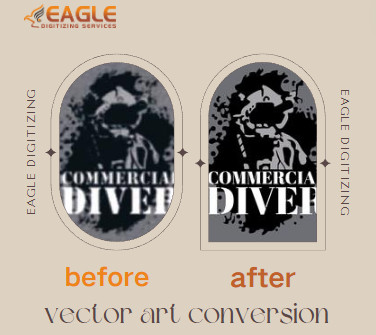Transform Designs: Embroidery Digitizing and Vector Cloning Tips
Embroidery digitizing is a fusion of traditional craftsmanship and modern technology, transforming artwork into intricate, thread-based masterpieces. This art form breathes life into designs, creating tactile, colorful expressions on fabric. Welcome to this fascinating world where creativity meets precision.
Why Vector Images Are Key to Embroidery Success
In embroidery digitizing, vector images play a pivotal role. These images, defined by mathematical equations, ensure sharp, scalable, and clean lines—perfect for translating intricate designs into stitch patterns. Unlike raster images, vectors maintain their quality at any size, making them indispensable for detailed and professional embroidery work.
Overview of the Digitizing and Cloning Process
The digitizing process involves converting artwork into a format that embroidery machines can read. This includes creating or importing vector images, refining them, and translating them into stitch commands. Cloning, or replicating designs for mass production, ensures consistency and efficiency in creating multiple identical pieces.
Getting Started
Essential Tools and Software for Digitizing
To begin digitizing, you’ll need robust tools. Essential software includes vector graphic programs like Adobe Illustrator or CorelDRAW, and digitizing software such as Wilcom or Brother PE-Design. Additionally, a reliable computer, a high-resolution monitor, and a graphics tablet can significantly enhance your workflow.
Setting Up Your Workspace for Success
A well-organized workspace is key to efficient digitizing. Ensure your area is clutter-free and equipped with all necessary tools within arm's reach. Good lighting, an ergonomic chair, and a spacious desk can also contribute to a productive and comfortable working environment.
Preparing Your Artwork for Vector Conversion
Before converting your artwork into vectors, ensure it is clean and well-defined. High-resolution images work best. Simplify complex details and remove unnecessary elements to make the vectorization process smoother. This preparation step is crucial for achieving a high-quality final product.
Refining Your Vector Design
Adjusting Paths and Curves for Precision
Precision is key in embroidery. Adjust paths and curves meticulously using the Direct Selection Tool in your vector software. Ensure that all lines are smooth and all shapes are closed. This level of detail will translate into a cleaner and more precise embroidery pattern.
Merging and Dividing Shapes for Clarity
To enhance clarity, merge or divide shapes where necessary. Use the Pathfinder Tool to combine or separate elements, creating a cohesive and clear design. This step is particularly important for complex designs with overlapping elements.
Using Layers to Organize Your Design
Organize your design using layers. Separate different elements into distinct layers to make editing easier and to ensure clarity in the digitizing process. Well-organized layers allow for efficient adjustments and troubleshooting.
Adding Details and Texture
Incorporating Small Details into Vectors
Small details can make a big impact. Use the Pen Tool to add intricate elements to your vector design. Pay attention to scale and proportion, ensuring that these details will translate well into embroidery stitches.
Using Textures to Enhance Your Design
Textures add depth and interest to your design. Experiment with different patterns and textures using Illustrator’s Texture Tool or similar features. Apply them subtly to enhance your artwork without overwhelming the primary design elements.
Creating Depth and Dimension with Shading
Shading creates a sense of depth and dimension. Use gradients and shading techniques to add volume to your design. This can make your embroidery more dynamic and visually appealing.
Coloring Your Vector Design
Exploring Color Theory for Embroidery
Understanding color theory is crucial for effective embroidery design. Complementary, analogous, and triadic color schemes can enhance your design’s visual appeal. Experiment with different palettes to find the most harmonious combinations.
Applying Fills, Strokes, and Gradients
Apply fills and strokes to define areas of color. Gradients can add subtle shading and highlights, making your design more lifelike. Use the Gradient Tool to create smooth transitions between colors, enhancing the overall depth of your design.
Creating Custom Color Palettes
Develop custom color palettes tailored to your design. Save these palettes in your vector software for consistency. Custom palettes ensure that your colors are unique and aligned with your artistic vision.
Preparing Your Vector for Digitizing
Understanding Embroidery File Formats
Embroidery machines read specific file formats such as DST, PES, or EXP. Every format has unique needs for compatibility and specs. Familiarize yourself with these formats to ensure your vectors are correctly translated into stitch data.
Exporting Vectors for Digitizing Software
Export your vector design in a format compatible with your digitizing software, typically SVG or AI. Ensure that all layers and elements are intact and properly organized. This preparation step is crucial for a smooth transition to the digitizing stage.
Ensuring Compatibility with Embroidery Machines
Check your embroidery machine’s specifications to ensure compatibility. Different machines may require different file formats or settings. Ensuring compatibility at this stage can prevent issues during the actual embroidery process.
Digitizing Your Vector Image
Choosing the Right Digitizing Software
Select digitizing software that suits your needs and skill level. Wilcom, Brother PE-Design, and Hatch are popular choices, each offering unique features and tools. Explore these options to find the best fit for your workflow.
Setting Up Your Design in the Digitizing Program
Import your vector design into the digitizing software. Set up the design by adjusting the hoop size, fabric type, and other parameters. This step ensures that the digitized design is optimized for your specific project.
Converting Vectors to Embroidery Stitches
Use the software’s tools to convert vector paths into stitch data. Adjust stitch types, densities, and directions to match your design’s requirements. This process transforms your vector image into a detailed and precise embroidery pattern.
Optimizing Stitch Types and Density
Different Types of Stitches and Their Uses
Embroidery offers a variety of stitch types, each suited for different effects. Satin stitches are perfect for smooth, flowing lines, while fill stitches cover larger areas with texture. Understanding these stitch types and their uses is essential for creating effective designs.
Adjusting Stitch Density for Different Fabrics
Stitch density affects both the look and durability of your embroidery. Adjust density settings based on the fabric type to ensure optimal results. Too dense can cause puckering, while too sparse may lead to loose threads.
Avoiding Common Stitching Issues
Common issues like thread breaks, puckering, or misalignment can be avoided with careful planning. Test your design on similar fabric before starting the final piece. Make necessary adjustments to stitch types and densities to avoid these problems.
Adding Special Effects
Incorporating Appliqué into Your Designs
Appliqué adds a unique dimension to embroidery. Use fabric pieces to create bold shapes and textures within your design. Plan the appliqué sections carefully, ensuring they align perfectly with the rest of the embroidery.
Using 3D Puff and Raised Embroidery Techniques
3D puff and raised embroidery create striking, elevated designs. These techniques require special foam and careful planning. Adjust your stitch settings to accommodate the foam and achieve the desired three-dimensional effect.
Adding Sequins, Beads, and Other Embellishments
Enhance your designs with sequins, beads, and other embellishments. These elements add sparkle and texture, making your embroidery truly stand out. Plan their placement carefully to ensure they integrate seamlessly with the stitched design.
Testing Your Design
Running Test Stitches on Different Fabrics
Before committing to your final piece, run test stitches on different fabrics. This makes modifications possible and aids in identifying possible problems. Testing ensures that your design translates well across various materials.
Troubleshooting Common Problems
Encountering issues is part of the process. Common problems like thread breaks or misalignment can be addressed by tweaking settings, adjusting stitch types, or refining your design. Patience and persistence are key to troubleshooting effectively.
Making Necessary Adjustments for Perfection
Perfection is achieved through iteration. Make necessary adjustments based on your test results. Refine your design, tweak stitch settings, and ensure everything is aligned perfectly. This meticulous attention to detail yields a perfect finished product.
Cloning Your Design
The Concept of Cloning in Embroidery
Cloning involves creating identical copies of a design for mass production. This technique ensures consistency and efficiency, allowing you to replicate your artwork precisely across multiple pieces.
Techniques for Creating Identical Copies
Use templates and presets in your digitizing software to create identical copies. These tools ensure that each reproduction matches the original design perfectly, maintaining uniformity across all pieces.
Using Cloning for Mass Production
Cloning is essential for mass production, whether for commercial purposes or large-scale projects. This technique allows for efficient production while maintaining high-quality standards.
Maintaining Consistency
Ensuring Uniformity Across Multiple Pieces
Consistency is crucial in embroidery. Use standardized settings and templates to ensure uniformity across multiple pieces. Regularly check your work for discrepancies and make adjustments as needed.
Using Templates and Presets for Efficiency
Templates and presets streamline the digitizing process. Save frequently used settings and designs as templates to speed up your workflow. You may concentrate on the more creative areas of your work thanks to this efficiency.
Quality Control Tips for Professional Results
Implement quality control measures to ensure professional results. Regularly inspect your work for errors, maintain your equipment, and use high-quality materials. These practices contribute to a polished and professional final product.
Saving and Organizing Your Work
Best Practices for File Management
Effective file management is essential for maintaining an organized workflow. Save your work in clearly labeled folders, use consistent naming conventions, and regularly back up your files. These practices prevent data loss and make finding files easier.
Creating a Digital Library of Designs
A digital library of designs allows for easy access and reference. Organize your library by categories, tags, or themes to quickly locate specific designs. This resource can streamline future projects and inspire.
Backing Up Your Work to Avoid Data Loss
Regularly back up your work to prevent data loss. Use external hard drives, cloud storage, or both to ensure your designs are safe. Regular backups provide peace of mind and safeguard your creative efforts.
Tips and Tricks for Success
Staying Up-to-Date with Industry Trends
Stay informed about the latest trends and techniques in embroidery. Follow industry blogs, subscribe to newsletters, and attend workshops to keep your skills current. Staying up-to-date ensures your work remains relevant and competitive.
Experimenting with New Techniques and Styles
Never be scared to try out novel methods and aesthetics. This exploration can lead to innovative designs and unique artistic expressions. Embrace the learning process and be open to new possibilities.
Learning from Mistakes and Continuous Improvement
Mistakes are growth opportunities. Analyze what went wrong and how to improve. Continuous learning and improvement are key to mastering embroidery digitizing online and achieving artistic excellence.
Embroidery digitizing is a blend of art and technology, requiring precision, creativity, and technical skill. From creating vector images to refining and digitizing them, each step is crucial for successful embroidery.
Embroidery digitizing offers endless creative possibilities. Continue learning, growing, and stretching the limits of your imagination. Innovation and persistence lead to artistic growth and success.
.png)


